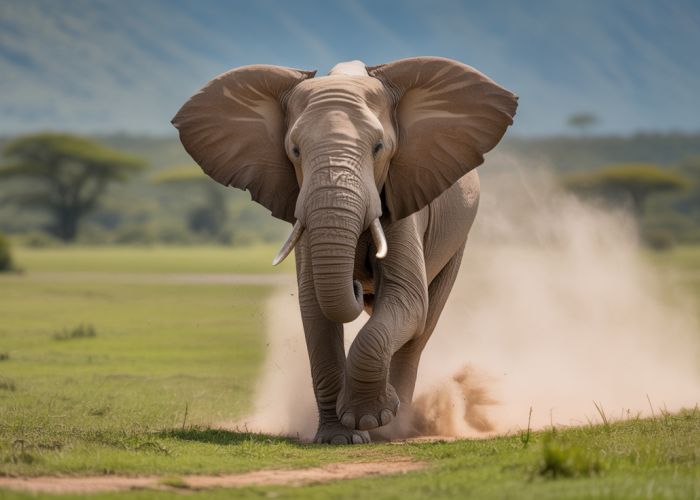The African Elephant, known for its immense size and impressive intelligence, presents a compelling question: what is its maximum velocity? Understanding the speed of elephant requires considering the terrain of the Serengeti, their typical habitat. While often perceived as slow-moving, the speed of elephant can surprise many, exhibiting bursts of surprisingly agile movement when needed. These bursts may be needed if a predator is near a calf, and the mama elephant needs to respond quickly!

Elephant Speed: Unveiling How Fast These Giants Actually Run
Elephants, with their immense size and powerful build, are often perceived as slow-moving creatures. While they are not built for sustained, high-speed chases like cheetahs, their bursts of speed can be surprisingly impressive. Understanding the speed of elephants requires delving into their physical capabilities and the circumstances under which they exhibit their fastest paces.
Understanding Elephant Locomotion
Before diving into actual speeds, it’s crucial to understand how elephants move. They primarily utilize two gaits: walking and a faster gait that is often mislabeled as running.
Walking Gait
- This is the elephant’s most common mode of transportation.
- It involves always having at least one foot on the ground.
- The walking pace is relatively slow and energy-efficient, allowing elephants to cover long distances in search of food and water.
The "Fast Walk" or "Ambling" Gait
- Elephants don’t actually "run" in the traditional sense, where all four feet are off the ground at the same time.
- Instead, they use a rapid, ambling gait that looks faster than their usual walk.
- This gait is characterized by a stiff-legged motion, where the elephant moves both legs on one side of its body almost simultaneously, followed by the legs on the other side.
- Some researchers refer to this as a "grounded run" because at least one foot remains on the ground.
Factors Influencing Elephant Speed
The maximum speed an elephant can achieve depends on a variety of factors:
- Age and Size: Younger elephants might be more agile but lack the power of adults. Mature, healthy adults are capable of the highest speeds.
- Terrain: Elephants reach higher speeds on flat, firm ground. Rough terrain, obstacles, or soft sand slow them down significantly.
- Motivation: An elephant’s motivation plays a key role. A frightened or angry elephant will move faster than one calmly foraging.
- Species: While generally similar, slight variations in build and muscle structure might influence speed among African bush elephants, African forest elephants, and Asian elephants.
Quantifying Elephant Speed: The Numbers
Determining the exact speed of an elephant can be challenging. Most measurements are estimates based on observation and tracking. However, here’s a general idea:
- Average Walking Speed: Around 4-6 km/h (2.5-3.7 mph).
- Maximum Speed (Fast Walk/Ambling): Up to 40 km/h (25 mph) for short bursts.
This table summarizes the speed capabilities:
| Gait | Speed (km/h) | Speed (mph) | Description |
|---|---|---|---|
| Walking | 4-6 | 2.5-3.7 | Normal, energy-efficient movement |
| Fast Walk/Ambling | Up to 40 | Up to 25 | Short bursts, used when alarmed or charging |
Comparing Elephant Speed to Other Animals
While 25 mph might seem impressive, consider how it stacks up against other animals:
- Cheetah: The fastest land animal, capable of reaching speeds of 80-130 km/h (50-80 mph).
- Lion: Can reach speeds of up to 80 km/h (50 mph) in short bursts.
- Human: An elite sprinter can reach speeds of around 36-40 km/h (22-25 mph) for a very short distance.
The key takeaway is that, while not the fastest animals, elephants are capable of surprising bursts of speed that should not be underestimated, particularly when they feel threatened. The power behind their movement makes them formidable even at relatively lower speeds.
Elephant Speed: FAQs
Here are some frequently asked questions about how fast elephants can actually run and other related information.
What’s the typical running speed of an elephant?
While they can’t truly "run" in the way other animals do, elephants can move surprisingly fast. Their top speed is typically around 15 miles per hour for short bursts. Remember, this isn’t a sustained running speed of elephant, but more of a fast walk or lumbering gallop.
Is there a difference in speed between African and Asian elephants?
Generally, no significant difference in top speed exists between African and Asian elephants. The speed of elephant is mainly determined by factors like age, health, and terrain, rather than species.
Why can’t elephants run like other animals?
Elephants lack the necessary anatomy for a true running gait. Their legs don’t have the required flexibility and springiness. When an elephant increases its speed, it uses more of a fast walk where at least one foot is always on the ground. Therefore, elephant speed is limited by their unique body structure.
Is the ‘running’ speed of elephant dangerous to people?
While 15 mph might not sound incredibly fast, an elephant’s size and weight make that speed very dangerous. Being trampled by an elephant moving at that speed could cause serious injuries or even death. It’s vital to keep a safe distance from elephants in the wild.
So, there you have it! Hopefully, you’ve learned a thing or two about the surprising speed of elephant. Now you can impress your friends with your newfound knowledge. Until next time!